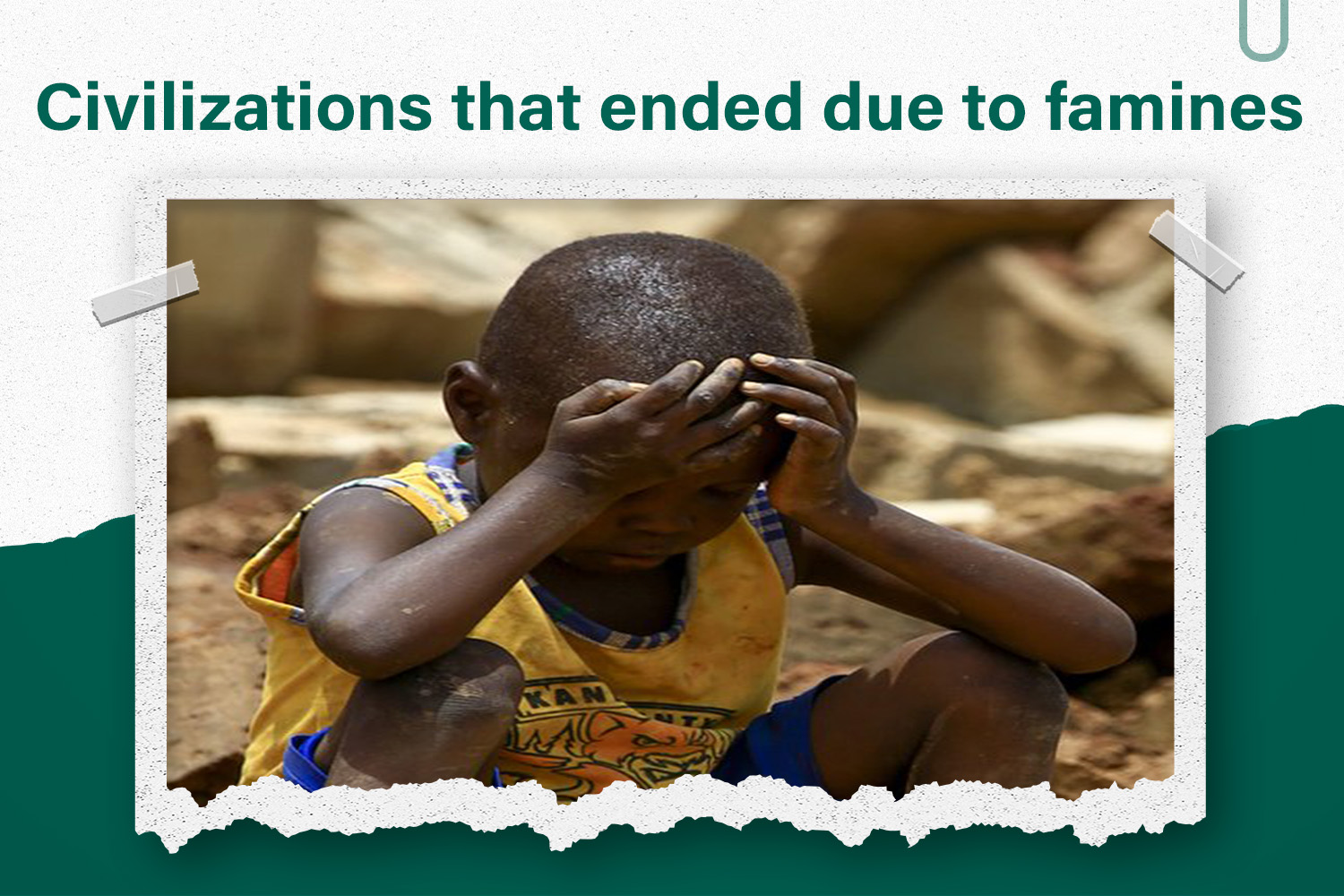Famines are one of the most serious disasters that humanity can face, they affect health, economy, culture, lead to scarcity of resources, increase poverty and hunger. Humanity has experienced several famines throughout history,and many civilizations have been affected by them.
Definition of famines and their impact on previous civilizations
Famine is defined as an acute shortage of food resources, which leads to high food prices, deterioration of Health and mortality. Previous civilizations, such as the Greeks and Romans, experienced violent famines that caused the deterioration of their economy and the depletion of their resources, and those civilizations also suffered from a high percentage of germs and diseases, which led to the collapse of some of them.
The ancient civilization of Egypt also suffered from numerous famines, specifically in the Mamluk era, which witnessed a noticeable rise in grain prices and an acute shortage of food resources, which led to a deterioration in the health situation, the emergence of diseases, the spread of hunger and poverty.
Proper handling of various crises remains the best solution to avoid the risks of famines, which must be taken care of Permanently in all countries of the world.
Civilizations that ended due to famines are a new reality
Toltec civilization
The history of the Toltec civilization and the reasons for its decline due to famines
The Toltec civilization was one of the most important ancient American civilizations that originated in the Andalusian Valley region of southern Mexico. It was marked by the development of the arts of construction, agriculture and science. But the numerous famines that befell civilization had a significant impact on the decline and extinction of Toltec.
The decline of Toltec coincided with a period of severe famines, during which civilization was subjected to an acute shortage of food and Water Resources, a rise in temperatures. Toltec has been affected by viruses, insects and parasites that affect crops and animals.

The impact of famines on agriculture and the economy of the Toltec civilization
Agriculture in Toltec was damaged by a lack of food and water resources, and the production of agricultural crops stopped. Industry and trade in the Toltec civilization were affected by its famines, as the economy deteriorated and the Toltec social and political system collapsed. Handicrafts and trade were particularly affected by the high prices of goods and the shortage of raw materials.
It is important to emphasize that the Prevention of famines is a top priority in modern societies, we must provide resources and support to our farmers and work to improve agricultural land, so that the same mistakes that happened in Toltec and sowed destruction in it are not repeated.
Resurrection Islands
The impact of famines on the inhabitants of the resurrection Islands and what happened to them
The resurrection islands are one of the most famous natural monuments of the Pacific Ocean, considered one of the most secluded places in the world. But in a certain period the region was struck by several famines that led to the death of many islanders.
Due to the lack of food and Water Resources, the inhabitants of the resurrection Islands experienced great difficulties during the famines that hit the region, experiencing hunger, thirst and the spread of diseases due to lack of Hygiene and sanitation.
Anecdotes mention that whole families migrated from the resurrection islands in search of food and water, and some residents resorted to eating insects, reptiles and other living creatures to avoid starvation.
Challenges of Agriculture in the resurrection Islands and food sources in light of famines
The resurrection islands are experiencing significant challenges in agriculture due to the difficulty of accessing clean water and the scarcity of Natural Resources, which makes agricultural production scarce.
The local government is currently trying to find new sources of food, such as fishing and internal trade, in addition to the production of feed and the subsequent breeding of animals to expand the food resource base and provide more food, especially in times of famine.
Until now, the people of the resurrection islands are still learning how to cope with this difficult situation, relying heavily on innovation and adaptation to the harsh conditions that strike the region.

Vikings
The Vikings specialized in agriculture, livestock, hunting and the causes of widespread famines
The Vikings were an agricultural, pastoral and hunting society, as they depended on local natural resources for food. Famines were considered one of the causes of the spread of diseases in the Viking society due to the lack of nutrients and nutritional needs necessary for the body.
The impact of famines on the spread of diseases in Viking society
Due to famines, there was a rise in food and water shortages and poor hygiene, causing outbreaks and spread of diseases among members of the Viking community. The living environment was cramped and unhealthy, which led to the rapid and devastating spread of diseases.
In general, famines had a significant impact on Viking society, which prompted them to look for new solutions to meet their nutritional needs and improve the living environment to reduce the spread of diseases.
Mayan civilization
The impact of famines on the Mayan civilization and the cause of its collapse
One of the main factors that led to the collapse of the Mayan civilization was famines. This civilization was based on the cultivation of corn, beans, cotton and other crops, and the lack of rains, floods and droughts were considered significant causes of famines. Because of these famines, thousands died, their farms were destroyed and they lost their sources of income.
Weather, climatic conditions and how they affect agriculture in the Mayan civilization
Weather and climatic conditions were considered a decisive factor in growing crops in the Maya civilization, as they depended on rains to water crops. Due to the lack of any advanced agricultural technologies as is happening at the moment, people needed to rely on the nature of the land and climatic conditions, which made them vulnerable to the impact of changing natural conditions. Therefore, the Mayan civilization was constantly exposed to famines, diseases and other violent natural events, which ultimately led to the collapse of this great civilization.
Ethiopian civilization
What is the reason for the decline of Ethiopian civilization due to famines
Ethiopian civilization suffered from the effects of varying natural phenomena, among these challenges were famines, which were attributed to the lack of rain, dry soil and desertification in many areas. The food shortage that resulted from these conditions is one of the main reasons for the decline of that civilization, as famines significantly changed the way of life in it, caused the death of millions of people and left hundreds of thousands of them to seek refuge and homelessness, and rural economies declined in that period.
Agricultural sustainability and the prospects of facing famines in current civilizations
Agricultural sustainability has become increasingly important to avoid the consequences of famines by diversifying crops and improving agriculture in different natural conditions. The opportunities for farmers and the cultivation of diverse crops that are able to withstand drought and other natural factors have been improved, thereby helping to alleviate the pressures on infrastructure and damaged rural economies. Work is still underway to develop those solutions and initiatives to improve the agricultural situation and create the sustainable economic opportunities needed by different parts of the world.
How do famines affect the environment
Famines and their impact on biodiversity and species extinction
Famines cause the destruction of wildlife and vegetation and go along with a decrease in the number of trees and an increase in barren areas. This affects biodiversity and eliminates various biotic species. Some animals are threatened with extinction due to famines, such as the case of Tegal in Ethiopia, where the Abyssinian deer species is in danger of extinction.
Sustainability of agricultural practices and food security in the world
With a large number of famines occurring in the world, international bodies are urging to take measures to prevent them and avoid their repercussions by improving agricultural practices more broadly, and cooperating to implement thoughtful initiatives. This process requires enhancing sustainability and expanding existing agricultural opportunities to help maintain a healthy environment and reduce the impact of famines on food security in the world.
Ahad society and confronting famines in Africa
AHAD is an association working in Africa founded in 1998 with the purpose of combating famine and poverty in developing countries, especially in Africa. The association works to improve the lives of local residents and achieve food security through the implementation of many projects aimed at improving local agriculture, providing safe drinking water and training farmers to improve agricultural practices.

Thus, the international community should unite to adopt such technologies and work together to improve agriculture, manage water resources and adapt to climate challenges to prevent famines.
Abstract
How do famines affect civilizations, the environment and the economy
Famines significantly affect civilizations, the environment and the economy, which can lead to a deterioration in the socio-economic and political conditions of the affected countries. It is known that famines affect the soil, decrease soil quality and lead to the deterioration of plant and animal life, and therefore affect the environment significantly.famines also affect the local and global economy and lead to huge losses in the GDP of countries with weak economies.
Related articles:







